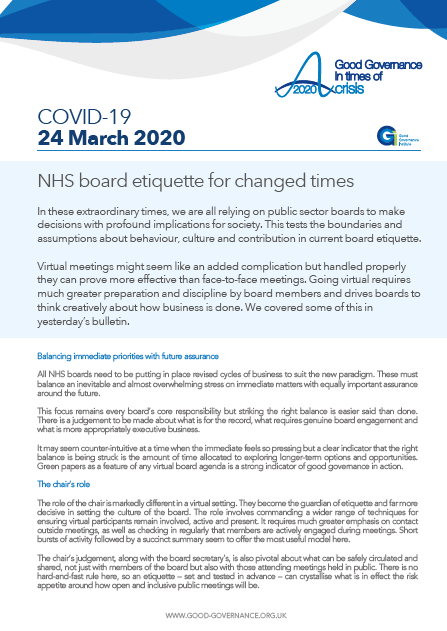NHS board etiquette for changed times
24 March 2020

As part of our work to support the NHS and promote effective governance in times of crisis, the Good Governance Institute (GGI) will be bringing out a series of practical briefings for NHS boards.
Virtual meetings might seem like an added complication but handled properly they can prove more effective than face-to-face meetings. Going virtual requires much greater preparation and discipline by board members and drives boards to think creatively about how business is done. We covered some of this in yesterday’s bulletin.
Balancing immediate priorities with future assurance
All NHS boards need to be putting in place revised cycles of business to suit the new paradigm. These must balance an inevitable and almost overwhelming stress on immediate matters with equally important assurance around the future.
This focus remains every board’s core responsibility but striking the right balance is easier said than done. There is a judgement to be made about what is for the record, what requires genuine board engagement and what is more appropriately executive business.
It may seem counter-intuitive at a time when the immediate feels so pressing but a clear indicator that the right balance is being struck is the amount of time allocated to exploring longer-term options and opportunities. Green papers as a feature of any virtual board agenda is a strong indicator of good governance in action.
The chair’s role
The role of the chair is markedly different in a virtual setting. They become the guardian of etiquette and far more decisive in setting the culture of the board. The role involves commanding a wider range of techniques for ensuring virtual participants remain involved, active and present. It requires much greater emphasis on contact outside meetings, as well as checking in regularly that members are actively engaged during meetings. Short bursts of activity followed by a succinct summary seem to offer the most useful model here.
The chair’s judgement, along with the board secretary’s, is also pivotal about what can be safely circulated and shared, not just with members of the board but also with those attending meetings held in public. There is no hard-and-fast rule here, so an etiquette – set and tested in advance – can crystallise what is in effect the risk appetite around how open and inclusive public meetings will be.
Board etiquette for virtual meetings
Perhaps even more critical to an effective virtual board than smooth-running technology is a strong board etiquette that’s been specifically designed for the rhythm and psychology of virtual meetings. This is a step beyond the etiquette for face-to-face meetings, such as the model GGI previously developed. https://www.good-governance.org.uk/services/good-governance-board-etiquette/
Much of the core etiquette will remain the same but etiquette for virtual boards should also include:
- a higher level of commitment to preparation by all board members – this includes a belief that pre-reading is an issue of fundamental respect to other board members
- rigour on synthesising the essence of an issue rather than agendas dominated by a ‘reporting-in’ culture – this includes much more concise board papers backed up if necessary, by more shared between meetings
- more systematic pre-discussion between board members to identify best use of time spent collectively
- commitment to discipline about contribution and attentiveness – an explicit commitment to avoiding multitasking and emailing during meetings is essential
- joint intent to create an environment of collective problem solving – long a goal for many boards but made more essential in a virtual world
- agreement to conduct as much routine business as possible in advance of the formal board meeting.
Recording meetings
Another practical consideration is the recording of meetings. There is a difference been live streaming for inclusiveness and allowing an independent recording to be made that could be used independently – potentially selectively – to cause reputational damage.
The etiquette should make clear that those attending meetings, including the public, are not entitled to create their own record of events. This matters all the more given the sensitive or controversial issues that might be discussed.
Thinking ahead and seeking outside help
It is sensible to create a new etiquette for virtual meetings and work it through with board members before any meetings go live. This can offer a much-needed development opportunity in its own right. It will certainly provide a useful prompt for individual conversations about expectations and contributions between the chair, the secretariat and each board member in the new world.
Chairs and board secretaries may want to test their thinking on remodelling the way their board works with someone outside their organisation. GGI is happy to act as a challenge and support around developing and testing bespoke etiquettes and cycles of business to carry public bodies through the next few months. We recognise that this is not easy to do but we can help.
What must never be compromised are the foundations of good governance and boards’ commitment to openness and collective engagement with difficult issues, however challenging this may prove to deliver in practice.
Call to action
GGI will be tracking how boards are managing virtual meetings and sharing experiences. We would like to hear how your first full virtual board meeting goes. Please email your experiences and any hints and tips to gitoc@good-governance.org.uk

